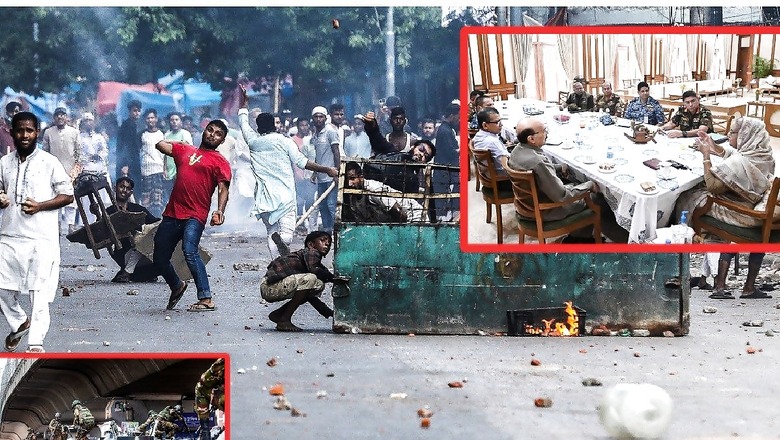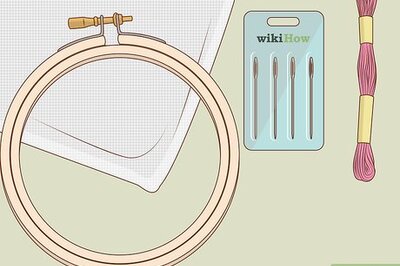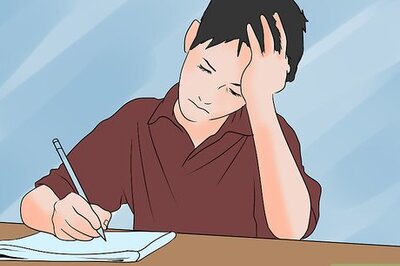
views
Protesters in Bangladesh said that they will continue with the protests demanding an end to a job quota rule even after a verdict from the Bangladesh Supreme Court scaled back the controversial quota system.
The ruling curtailed the number of reserved jobs, from 56 percent of all positions to seven percent, but fell short of meeting protester demands.
It reserved five percent of all government jobs for the children of “freedom fighters” from Bangladesh’s 1971 liberation war against Pakistan, down from 30 percent. One percent were reserved for tribal communities, and another one percent for people with disabilities or identifying as third gender under Bangladeshi law.
The remaining 93 percent of positions would be decided on merit, the court ruled. However, student leaders remain adamant that their voices have not been heard.
“We welcome the Supreme Court verdict. But we won’t call off our protests until the government issues an order reflecting our demands,” a spokesman for Students Against Discrimination, the main group responsible for organising the protests, told AFP.
Police imposed a strict curfew with a “shoot-on-sight” order across Bangladesh after 133 people were killed in nationwide civil unrest. The deadly clashes between police and university students were sparked by the future of civil service hiring rules, on which the country’s top court is due to rule on Sunday (July 21).
Soldiers patrolled parts of Dhaka on Saturday (July 20) after the protests snowballed into some of the worst in Prime Minister Sheikh Hasina’s tenure. Not only students, but other citizens have also joined in demanding the resignation of the government.
The military has now taken over after riot police failed to quell the unrest, which started as being against politicised admission quotas for sought-after government jobs. Bangladesh has also been under an internet blackout since July 18, drastically restricting the flow of information to the outside world.
The reason behind the unrest, the civil service jobs allocation system reserves more than half of the posts for specific groups, including children of veterans from the country’s 1971 liberation war against Pakistan. Critics have time and again pointed out that these quotas benefit those loyal to Hasina, who has ruled the country since 2009.
The 76-year-old leader won her fourth consecutive term in January after a vote without genuine opposition. Her government is accused by rights groups of misusing state institutions to become more powerful and stamp out dissent, including by the extrajudicial killing of opposition activists.
The quota system reserves up to 30 per cent of government jobs for relatives of veterans who fought in the 1971 war. It is a source of resentment among the youth, who are facing an acute job crisis in a country unable to provide adequate employment opportunities to its population of 170 million. The demonstrations — called for mainly by student groups — started weeks ago.
In 2018, the government halted the quotas following mass student protests. But, in June, Bangladesh’s High Court nullified that decision and reinstated the system after relatives of 1971 veterans filed petitions. The Supreme Court suspended the ruling, pending an appeal hearing.
Here are the latest updates:
- The Supreme Court ordered that the veterans’ quota be cut to 5%, with 93% of jobs to be allocated on merit. The remaining 2% will be set aside for members of ethnic minorities and transgender and disabled people.
- Student leaders, however, have said that they will not call off the protests. “We welcome the Supreme Court verdict. But we won’t call off our protests until the government issues an order reflecting our demands,” a spokesman for Students Against Discrimination, the main group responsible for organising the protests, said.
- Bangladesh PM Sheikh Hasina held a key meeting with Bangladesh’s three service chiefs and the cabinet secretaries to review the nation’s security situation.
- At least 545 people entered through the check post in West Bengal’s Changrabandha. At least 333 Indians, 186 Nepalis, 25 Bhutanese and 1 Maldivian entered India from Bangladesh.
- The external affairs ministry said that over 4,500 Indian students have returned back home and that the High Commission has made arrangements for security escort for safe travel of Indians in Bangladesh to border-crossing points.
- Hasina allegedly inflamed tensions this month by likening protesters to the Bangladeshis who had collaborated with Pakistan during the country’s independence war. She was due to leave the country on Sunday (July 21) for a diplomatic tour to Spain and Brazil but cancelled her plans.
- The US has recommended that its citizens do not travel to Bangladesh and allowed the voluntary departure of its non-emergency government employees and family members. This comes a day after it issued a new travel advisory, urging Americans to reconsider their travel to the strife-torn country. The US Department of State raised the Travel Advisory Level for Bangladesh to Level 4 — ‘Do Not Travel’.
- Officials said the curfew was to quell further violence after police and protesters clashed in the streets and at university campuses in Dhaka and other cities. It began at midnight on Saturday (July 20) and was relaxed from noon to 2 pm for people to run essential errands. It is expected to end on Sunday. It allows officers to fire on mobs in extreme cases, said lawmaker Obaidul Quader, the general secretary of the ruling Awami League party.
- July 19 was likely to be the deadliest day so far; Somoy TV reported 43 killed, while an Associated Press reporter saw 23 bodies at Dhaka Medical College and Hospital, but it was not immediately clear whether they all died on that day. On July 18, 22 others were reported dead as protesting students attempted to “completely shut down” the country. Bangladeshi authorities have not shared any official numbers of those killed and injured.
- Authorities blocked online communications by banning mobile and internet services. Several television news channels also went off the air, and the websites of most local newspapers were down. Some key government websites, meanwhile, including Bangladesh’s central bank and the prime minister’s office, appeared to have been hacked and defaced. Local media also reported that some 800 inmates fled from a prison in Narsingdi, a district north of Dhaka, after protesters stormed the facility and set it on fire on July 19.
- Representatives from both sides met late on July 19 in a bid to resolve issues. At least three student leaders were present and demanded the reform of the current quota system, the reopening of student dormitories shut by the police following the clashes and for some university officials to step down after failing to protect campuses from the violence. Law minister Anisul Huq said the government was open to discussing their demands.
- The main opposition Bangladesh Nationalist Party (BNP) has backed the protests, vowing to organise its own demonstrations as many of its supporters joined the protests. However, the party said its followers were not responsible for the violence and denied the ruling party’s accusations of using the protests for political gains. The Awami League and the BNP have often accused each other of fuelling political chaos and violence, most recently ahead of the national election that was marred by a crackdown on several opposition figures. Hasina’s government had accused the opposition party of attempting to disrupt the vote.
- India said at least 1,000 students returned to the country from Bangladesh through various land transit points or by flight as the violence escalated. External affairs minister S Jaishankar said his ministry is fully focused on ensuring safety and well being of the Indians in Bangladesh. Indian missions are in regular touch with authorities concerned to ensure safety and security of Indian nationals and students, the MEA said. “Thus far, 778 Indian students have returned to India through various land ports. In addition, around 200 students have returned home by regular flight services through Dhaka and Chittagong airports,” it said.
- The MEA said students from Nepal and Bhutan have also been assisted with crossing into India on request. In all, 284 more people entered India on Saturday (July 20) via Dawki integrated check post in Meghalaya’s West Jaintia Hills district. Officials said 168 are from Nepal and 115 from India, including eight students from Meghalaya, and one from Canada. “In the last three days, 953 people from India, Nepal and Bhutan, mostly students, and one from Canada have crossed over through Dawki ICP to the country from Bangladesh due to agitation there,” a senior home department official said. The Meghalaya government has activated a helpline number for those seeking assistance.
(With agency inputs)

















Comments
0 comment